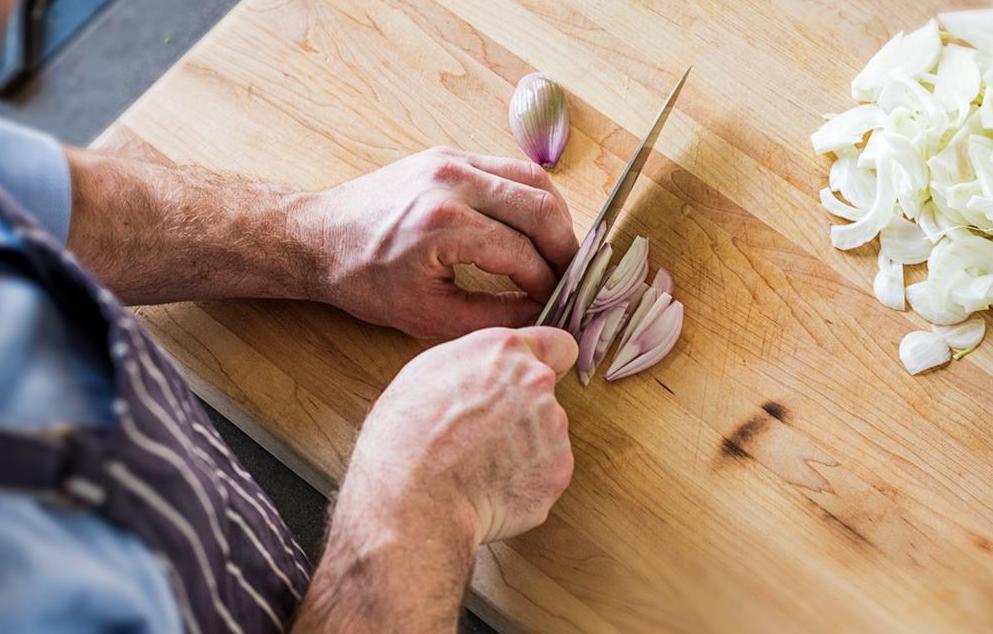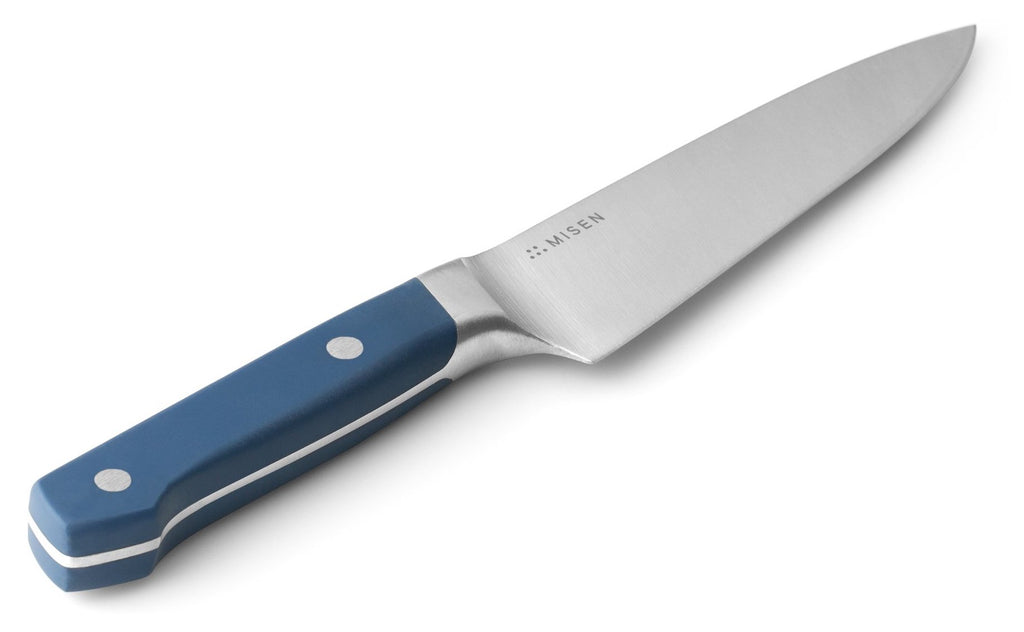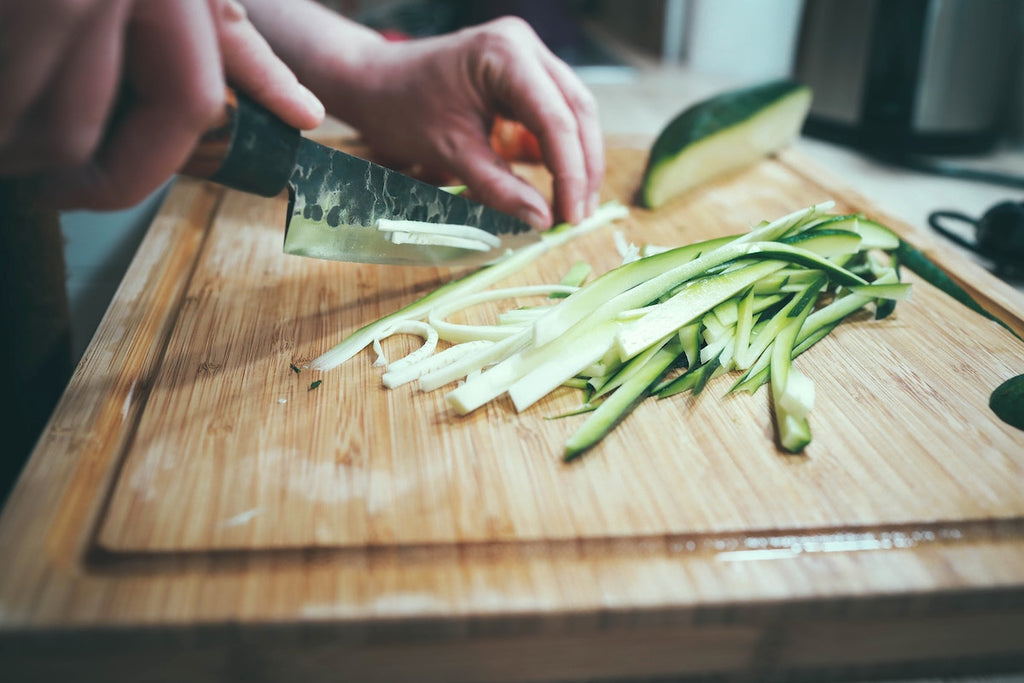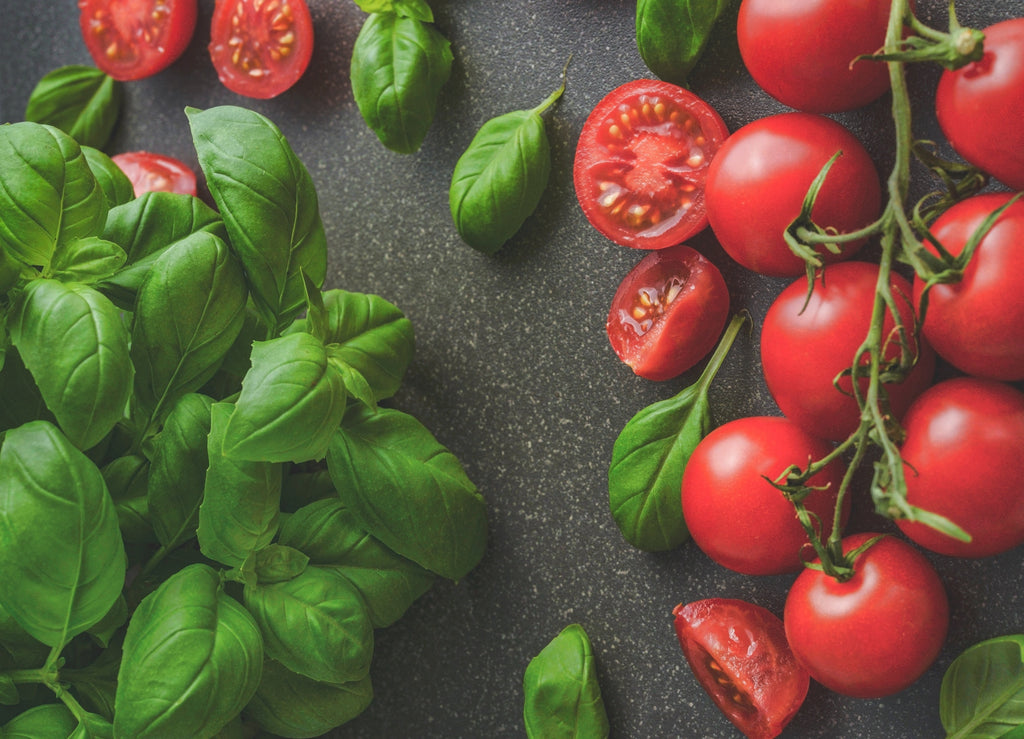How to Julienne: 3 Techniques for Any Type of Ingredient
 The two tools you need to julienne are a sharp knife and a large wooden cutting board.
The two tools you need to julienne are a sharp knife and a large wooden cutting board.
- The julienne cut is the thinnest strip cut, measuring 1/16 or 1/8-inches wide and 2-3 inches long.
- Julienne cuts lend themselves well for toppings, sidings, and garnishes.
- The best knives to julienne are a chef’s knife, a santoku knife, or a utility knife.
Learning how to julienne is one of the first forays into more advanced (and more impressive) knife skills. Beyond the everyday chop, dice, and mince, the julienne is a finer, fancier cut that’s often used for garnishes, side dishes, or lighter fare.
The julienne cut also goes by the name matchstick cut or allumette, which is French for matchstick. Sometimes it’s simply referred to as a French cut.
No matter what it’s called, the julienne is a common requirement for recipes and a familiar sight on cooking shows — which makes it a great knife cut to master. Read on for everything you need to know about how to julienne.
What Is a Julienne
To julienne food is to cut it into thin, long strips that look like matchsticks. The strips can range from 2-3 inches long and from 1/16- to 1/8-inch thick, although the thinner cuts are usually considered a fine julienne.
Julienne cuts are the thinnest of all the strip cuts, coming right after the batonnet, which is 1/4-inch thick. And it’s the starting point for the cubed brunoise cut, which adds a few extra slices to create a 1/16- or 1/8-inch cube.
A good tip, if you don’t have access to a ruler, is to take a look at your hand. The top section of the thumb or the index finger — from the tip to the first knuckle — is roughly an inch. This of course varies per person, so it’s advised to verify by measuring your finger beforehand.
Given its fine and exacting dimensions, the julienne cut is commonly used for firm produce, such as apples, beets, carrots, celery, bell peppers, and root crops.
This thin uniform cut ensures a quick and even rate of cooking or marinating. When eaten raw in salads or slaws, julienned pieces add a delicate crunch and texture in a way that’s elegant and easy to chew.
Tools You Need to Julienne
 A utility knife is the perfect size to easily julienne smaller food items, like apples or small potatoes.
A utility knife is the perfect size to easily julienne smaller food items, like apples or small potatoes.
As with all forms of kitchen cutting, the julienne needs a sharp knife. Although it can also be done using specialty gadgets, such as julienne peelers, mandolines, and food processors, learning the basic knife technique is a good skill for all home cooks to have. Plus, unless you're planning to julienne quite a lot, you may want to use a more essential kitchen tool. A julienne peeler will spend most of its time taking up space.
The best knives for julienning are a chef's knife, a santoku knife, or a utility knife. A chef's knife is the most popular, as it has a convenient 8- to 10-inch long blade that can easily slice through most ingredients. Its slightly curved cutting edge has a double bevel (sharpened on both sides) between 20-30 degrees, making it perfect for all-around tasks. It’s also the natural choice when you’re already using it for other prep work.
A santoku is known as the Japanese-style alternative to a chef's knife. With a straight cutting edge and usually a single-bevel between 12-15 degrees — though many western knife manufactures now make it with a double bevel — the santoku is designed for sharp slicing. It also has a 5- to 8-inch blade, which is lighter, smaller, and works well for long bouts of cutting or cooks with smaller hands.
Utility knives are mid-sized, general purpose knives. With a blade that’s 4 to 7 inches in length, it’s smaller than a chef’s knife and larger than a paring knife. While a chef's knife or santoku would be too long to quickly julienne say, gala apples, radishes, or turnips, a utility knife would make quick work of these smaller items.
And of course, you also need a cutting board to julienne. With the number of cuts and tiny pieces (it’s surprising how a small fruit or vegetable can yield so much once julienned), the best board is one made of wood.
Wooden cutting boards can be naturally self-healing. The fibers go back together after cutting, which provides a smooth, hard-wearing surface that’s difficult for bacteria and mold to penetrate.
A wood cutting board in a size as large as your kitchen space allows is best for julienne cuts and all other knife cuts.
Getting Ready to Julienne
It's important to always start kitchen work by assembling the necessary tools and ingredients. Make sure your knife of choice is well-sharpened and all the ingredients have been rinsed and patted dry before placing them on a stable cutting board.
Use your dominant hand to hold the knife firmly. With your thumb and the knuckle of your index finger pinching the top of the blade right near the handle, let your remaining three fingers curl comfortably around the handle.
Your non-dominant hand will steady the ingredients. Keep your fingers curled inward to protect them from the blade, and remember to move your hand back along the pieces (and away from the knife blade) as you continue to cut.
How to Julienne the Traditional Way
 The traditional julienne involves “squaring off” or “regularizing” the ingredient.
The traditional julienne involves “squaring off” or “regularizing” the ingredient.
To illustrate how to carry out a traditional julienne, it’s best to start with something simple and familiar. Carrots are a popular vegetable, perfect for a julienne, as it helps break down the dense vegetable and create a lighter crunch.
Start by peeling the skin off the carrot. This step is optional, of course and depends on the particular ingredient or dish.
Trim off both ends of the carrot — the top stem and small root end. Divide the rest of the carrot into equal 2 or 3-inch segments. If there are any odd ends left, set these aside for another dish or toss them in your lunchtime salad.
Take one carrot segment and cut a thin slice off its length to create a flat side. Place the segment on its flat side and cut off another thin slice perpendicular to the first. Repeat for the other two sides. Once you have a small carrot rectangle, you have successfully “squared off” or “regularized” its shape. Square off all remaining segments.
The next step is to slice each carrot rectangle lengthwise into tiny 1/16- or 1/8-inch thick planks. Try to keep the planks as uniform as possible.
Then, it's time for the final step, which is to stack and slice. Stack the planks on top of each other and slice lengthwise at the same 1/16- or 1/8-inch thickness as in the previous step. This creates uniform matchstick-shaped carrots. Do the same for the rest of the planks, and congratulations! You’ve successfully julienned carrots.
How to Julienne Using a Shortcut
For times when the traditional method is too tedious or time-consuming, there’s another quicker way to julienne vegetables. It’s a two-step process that doesn’t require squared off segments or exact dimensions.
Instead once the ingredient has been properly washed (and peeled, if needed), simply start slicing it at a diagonal. Make the slices as thin as possible at about 1/16 to 1/8-inch apart.
Then stack the slices together and cut them into thin strips. You can cut them lengthwise for longer strips or crosswise for shorter strips. Aside from getting a good julienne without the need for exact measurements, this method also utilizes more of the produce and leads to fewer wasted ingredients.
This shortcut is more suitable for longer food items, like cucumber, daikon, or zucchini. The shape of these ingredients will give you enough room to make the diagonal slices long enough for a standard julienne.
How to Julienne Soft or Irregular-Shaped Items
 Julienning soft ingredients requires removing all seeds and inner membranes, leaving the firm skin for easy slicing.
Julienning soft ingredients requires removing all seeds and inner membranes, leaving the firm skin for easy slicing.
The traditional squaring off or shortcut methods are fine for most dense ingredients. But how about for ones that are soft (tomatoes), hollow (bell peppers), or layered (onions)?
While not as commonly done, there are specific techniques to julienne these items as well. The key is to separate the firm parts of the produce that can actually be julienned. In the case of tomatoes and bell peppers, this is the outer skin and any closely attached flesh.
Note that it may be better to use a utility knife or paring knife for this method. Smaller blades are easier to maneuver when removing seeds and pulp.
Begin by cutting off the stem and quartering the tomato or pepper. Taking each quarter, use your knife to cut out the inner seeds and pulp. Remove as much as you can, leaving the skin and flesh as clean as possible.
If the ingredient is on the larger side, you may have to cut the quarters in half crosswise for a 2-3-inch julienne.
Take a piece and use the fingers of your non-dominant hard to gently flatten it down while cutting. Slice into 1/16- or 1/8-inch strips. Do this for the rest of the pieces, resulting in a pile of nicely julienned produce.
Onions are another item that can’t be cut in the traditional julienne way. Fortunately, their layered structure is naturally suited for the thin strips of julienne. First slice off the two ends (the root and the stem), stand the onion on one of the ends, and slice the entire bulb in half down the middle.
Working with one half, peel off the outer layer and place the onion flat side down with the end facing toward you. Hold the onion half in place with your non-dominant hand. With the knife angled at 45 degrees to the cutting board, start slicing the onion into 1/16 to 1/8-inch pieces.
Work radially and adjust the angle as you cut — by the time you reach a quarter way through the onion half, your knife should be at 90 degrees to the cutting board. When you have about a quarter left, slicing at an angle can feel a bit awkward. At this point, simple flip the remaining onion on its other side and finish slicing. Repeat on the other onion half.
Stick With It
The julienne is a popular cut in the kitchen, as it allows ingredients to cook at a quick and even rate. Plus, its uniform appearance elevates the presentation of any dish.
Although the delicate cut looks intimidating, it can actually be accomplished in a few simple steps. Plus, there are several ways to julienne, depending on the particular ingredient and time available. The next time a recipe calls for a julienne, choose from one of the three methods above, and you’ll master the matchstick cut in no time.








